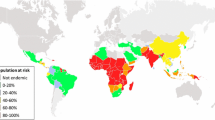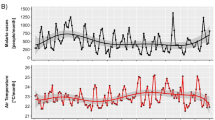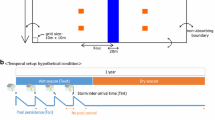Abstract
Seasonal total precipitation is well known to affect malaria transmission because Anopheles mosquitoes depend on standing water for breeding habitat. However, the within-season temporal pattern of the rainfall influences persistence of standing water and thus rainfall patterns can also affect mosquito population dynamics in water-limited environments. Here, using a numerical simulation, I show that intraseasonal rainfall pattern accounts for 39% of the variance in simulated mosquito abundance in a Niger Sahel village where malaria is endemic but highly seasonal. I apply a field validated coupled hydrology and entomology model. Using synthetic rainfall time series generated using a stationary first-order Markov Chain model, I hold all variables except hourly rainfall constant, thus isolating the contribution of rainfall pattern to variance in mosquito abundance. I further show the utility of hydrology modeling using topography to assess precipitation effects by analyzing collected water. Time-integrated surface area of pools explains 70% of the variance in simulated mosquito abundance from a mechanistic model, and time-integrated surface area of pools persisting longer than 7 days explains 82% of the variance. Correlations using the hydrology model output explain more variance in mosquito abundance than the 60% from rainfall totals. I extend this analysis to investigate the impacts of this effect on malaria vector mosquito populations under climate shift scenarios, holding all climate variables except precipitation constant. In these scenarios, rainfall mean and variance change with climatic change, and the modeling approach evaluates the impact of non-stationarity in rainfall and the associated rainfall patterns on expected mosquito activity.




Similar content being viewed by others
References
Ali A, Amani A, Lebel T, Ibrahima S (2006) In: Demuth S, Gustard A, Planos E, Scatena F, Servat E (eds) Climate variability and change-hydrological impacts. IAHS, Wallingford
Balme M, Vischel T, Lebel T, Peugeot C, Galle S (2006) Assessing the water balance in the Sahel: impact of small scale rainfall variability on runoff Part 1: rainfall variability analysis. J Hydrol 331:336–348
Bomblies A, Eltahir EAB (2009) Assessment of the impact of climate shifts on malaria transmission in the Sahel. Ecohealth 6(3):426–437
Bomblies A, Duchemin J-B, Eltahir EAB (2008) Hydrology of malaria: model development and application to a Sahelian village. Water Resour Res 44:W 12445. doi:10.1029/WR006917
Craig MH, Snow RH, LeSueur D (1999) A climate-based distribution model of malaria transmission in Sub-Saharan Africa. Parasitol Today 15:105–111
Gerbaux M, Hall N, Dessay N, Zin I (2009) The sensitivity of Sahelian runoff to climate change. Hydrol Sci 54(1):5–16
Gianotti RL, Bomblies A, Dafalla M, Issa-Arzika I, Duchemin JB, Eltahir EAB (2008) Efficacy of local neem extracts for sustainable malaria control in an African village. Malar J 7:138
Gillies MT, DeMeillon B (1968) The Anophelinae of Africa South of the Sahara. S. Afr. Inst. of Med Res, Johannesburg
Guillot G, Lebel T (1999) Disaggregation of Sahelian mesoscale convective system rain fields: further developments and validation. J Geophys Res – Atmos 104(D24):31,533–31,551
Hoshen MB, Morse AP (2004) A weather-driven model of malaria transmission. Malar J 3(32). doi:10.1186/1475-2875-3-32
Kelly-Hope LA, Hemingway J, McKenzie FE (2009) Environmental factors associated with the malaria vectors Anopheles gambiae and Anopheles funestus in Kenya. Malar J 8(268). doi:10.1186/1475-2875-8-268
Kiszewski A, Teklehaimanot A (2004) A review of the clinical and epidemiological burdens of epidemic malaria. Am J Trop Med Hyg 71(suppl 2):128–135
Koenraadt CJM, Paaijmans KP, Githeko AK, Knols BGJ, Takken W (2003) Egg hatching, larval movement, and larval survival of the malaria vector Anopheles gambiae in desiccating habitats. Malar J 2:20
Koenraadt CJM, Githeko AK, Takken W (2004) The effects of rainfall and evapotranspiration on the temporal dynamics of Anopheles gambiae ss and Anopheles arabiensis in a Kenyan village. Acta Trop 90:141–153
LeBarbe L, Lebel T (1997) Rainfall climatology of the HAPEX-Sahel region during the years 1950–1990. J Hydrol 189(1–4):43–73
Lebel T, Sauvageot H, Hoepffner M, Desbois M, Guillot B, Hubert P (1992) Rainfall estimation in the Sahel: the EPSAT-Niger experiment. Hydrol Sci J 37:201–215
Lebel T, Braud I, Creutin JD (1998) A space-time rainfall disaggregation model adapted to Sahelian mesoscale convective complexes. Water Resour Res 34(7):1711–1726
Martens WJ (1998) Health and climate change: modelling the impacts of global warming and ozone depletion. Earthscan, London
Mathon V, Laurent H (2001) Life cycle of Sahelian mesoscale convective cloud systems. Quart J Roy Met Soc 127(572):377–406
Mearns LO, Rosenzweig C, Goldberg R (1997) Mean and variance change in climate change scenarios: methods, agricultural applications, and measures of uncertainty. Clim Chang 35(4):367–396
Molineaux L, Gramiccia G (1980) The Garki Project. World Health Organ, Geneva, p 311
Pascual M, Cazelles B, Bouma MJ, Chaves LF, Koelle K (2008) Shifting patterns: malaria dynamics and rainfall variability in an African highland. Proc Roy Soc B 275:123–132
Patz JA, Strzepek K, Lele S, Hedden M, Greene S, Noden B, Hay S, Kalkstein L, Beier JC (1998) Predicting key malaria transmission factors, biting and entomological inoculation rates, using modeled soil moisture in Kenya. Trop Med Int Health 3(10):818–827
Waggoner PE (1989) Anticipating the frequency distribution of precipitation if climate change alters its mean. Agric For Meteorol 47:321–337
World Health Organization (2010). World Malaria Report 2010. Geneva: WHO, 2010. http://www.who.int/malaria/world_malaria_report_2010/worldmalariareport2010.pdf
Zhou G, Minakawa N, Githeko AK, Yan G (2004) Association between climate variability and malaria epidemics in the East African highlands. Proc Nat Acad Sci 101(8):2375–2380
Acknowledgements
This study was funded by National Science Foundation EPSCoR grant “Complex Systems Modeling for Environmental Problem Solving”. I acknowledge the helpful comments of two anonymous reviewers.
Author information
Authors and Affiliations
Corresponding author
Rights and permissions
About this article
Cite this article
Bomblies, A. Modeling the role of rainfall patterns in seasonal malaria transmission. Climatic Change 112, 673–685 (2012). https://doi.org/10.1007/s10584-011-0230-6
Received:
Accepted:
Published:
Issue Date:
DOI: https://doi.org/10.1007/s10584-011-0230-6




